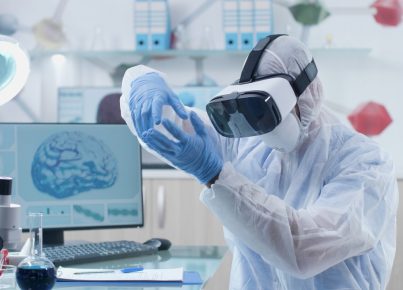All of the Bones in the Human Body
Bones make up the human skeleton, and it’s their job to provide the human body with structure and stability. By working with the muscles and joints in our bodies, all the bones in the human body support movement. Many bones also protect the human body’s most vital organs.
The diagram below will introduce you to the common names for the bones that make up the human skeleton; read on to find out about their scientific names and the groups they belong.
List of Bones in the Human Body
There are 206 bones in an adult human skeleton. The skeleton comprises the bones of the: skull, spine, chest, arms, pelvis, hands, legs, and feet. Where a number follows the name of the bone in brackets, this indicates how many of that bone are in the human skeleton.
The skull comprises 28 bones, including the facial and ear bones. The names of these bones are:
- Frontal,
- Parietal (2),
- Temporal (2),
- Occipital,
- Sphenoid,
- Ethmoid,
- Mandible,
- Maxilla (2),
- Palatine (2),
- Nasal (2),
- Zygomatic (2),
- Lacrimal (2),
- Vomer,
- Inferior nasal conchae (2),
- Malleus (2),
- Incus (2),
- Stapes (2).
Below the skull, the bone in our throat is called the:
- Hyoid.
The human spine is made up of 33 small bones which interlock with each other to form the backbone. These interlocking bones are called vertebrae and are divided into sections:
- Cervical vertebrae (7),
- Thoracic vertebrae (12),
- Lumbar vertebrae (5),
- Sacrum (5),
- Coccyx (4).
The chest of a human skeleton is made up of pairs of ribs and the breastbone; these bones are the:
- Sternum,
- Ribs (2 x 12).
Human arms are made up of five bones each. These are the following:
- Shoulder blade,
- Collar bone,
- Humerus,
- Radius,
- Ulna.
The human hand is made up of 27 bones. These bones include the following:
- Carpals (wrist) (8),
- Metacarpals (palm) (5),
- Proximal phalanges (fingers) (5 x 2),
- Intermediate phalanges (4 x 2),
- Distal phalanges (5 x 2).
Just above the legs is the pelvis. This is made up of three bones called:
- Hip bone,
- Sacrum,
- Coccyx.
The human leg is made up of four significant bones, these are:
- Femur,
- Patella,
- Tibia,
- Fibula.
And finally, the feet. A human foot is made up of 26 bones; these are:
- Talus (ankle),
- Calcaneus (heel bone),
- Tarsals (5),
- Metatarsals (forefoot) (5),
- Phalanges (toes) (14),
- Sesamoids (2).
What Are Bones Made Of?
We know what they are, but what are bones made of? All the bones in the human body are alive and growing all the time. Every bone in the human skeleton comprises layers, each being a different type of bone tissue. These bone tissue layers are:
Periosteum: the outer layer of bone is dense and contains blood vessels and nerves.
Compact tissue: this smooth layer is hard and protects the inner tissue of the bone. It’s this layer that is visible when looking at a skeleton.
Cancellous tissue: this sponge-like layer is lightweight and provides strength for bones.
Bone marrow: a jelly-like substance is the innermost part of the bone. It’s the job of bone marrow to produce blood cells.
Although there are around 206 bones in the human body, the human skeleton doesn’t weigh that much. The structure of bones means that they are lightweight while still allowing the human skeleton to support the weight of flesh, organs, muscles, and fat, as well as protecting vulnerable organs like the brain.
How Do Bones Grow?
Babies are much smaller than fully grown adults. So for us to increase in size, our bones have to grow.
A baby typically has around 300 bones at birth. Adults only have 206 bones, so what happens to the other 94 bones? Do they disappear? Well, not exactly. The 300 bones within a baby’s body gradually fuse as they grow to form the 206 bones that adults have. Some of the bones in a baby’s body are made entirely of cartilage, while others are only partly made up of this material. Cartilage is a soft, flexible material that, as children grow, is gradually replaced by bone.
As humans, our bones are finished growing by the time we are 25 years old.
What are Joints?
Joints are where 2 separate bones meet — they ‘join’ together, hence the name. The joints make our skeletons flexible; without them, we would have to move without bending. That would be like walking around like a doll.
Different joints operate and move differently, allowing us to move around freely. For example, some joints have a primary range of motion, such as knees and elbows, that just open and close. However, other joints, such as shoulders and hips, enable more advanced movement, allowing backward, forwards, sideways, and rotating movements.
Joints are classified by their range of movement:
- Immovable joints: Some joints, immovable or fibrous, do not move. One of the main immovable joints in the human body is the skull. The skull is made up of bony plates that move slightly during birth and then fuse as it finishes growing. Between the edges of these bony plates are little joints of fibrous tissue.
- Partially movable joints: These joints, also known as cartilaginous joints, are capable of a small amount of movement. These partially movable joints are linked together by cartilage. The vertebrae in the spine are cartilaginous joints since they’re connected by cartilage, and each moves concerning the one above and below it. All of the vertebrae in the spine work together to give the spine flexibility and, therefore, give us a full range of motion.
- Freely movable joints: Some joints in our bodies, known as synovial joints, can move in a wide range of directions. All the main joints in the human body, including those found in the hips, shoulders, elbows, knees, wrists, and ankles, are freely movable. These joints are filled with synovial fluid, which lubricates them, allowing them to move freely and easily.
Three kinds of freely movable joints in the human body play a big part in voluntary movement. They are as follows:
- Hinge joints: These kinds of joints allow movement in just one direction, as seen in the knees and elbows.
- Pivot joints: These kinds of joints allow a rotating or twisting motion, like the head moving from side to side.
- Ball-and-socket joints: These kinds of joints allow the most excellent range of movement. The hips and shoulders have ball-and-socket joints, in which the rounded end of a long bone fits neatly into the hollow of another bone.
Which Part of The Human Body Has The Most Bones?
The hands and feet have one-quarter of the bones in the human skeleton. Combined, they make up half of the bones in the human body.
Think about how many tasks these parts of the human skeleton can perform – the number of bones means that the hands and feet are divided into small sections that can move in their way.
What Are The Different Types of Bones in The Human Body?
All the bones in the human body belong to different groups. There are four different types of bone in the human body, these are:
- Long bone: these bones are longer and thinner, connected to muscles, supporting movement. Examples include the arm and leg bones.
- Short bone: these bones are smaller and more cubed in shape. Short bones provide support and stability. Examples include the wrist and ankle bones.
- Flat bone: these broad bones protect the body’s most vital organs. They include shoulder blades, skull bones, and ribs.
- Irregular bone: irregular bones are simply those that don’t belong to the shapes outlined above, like vertebrae.
What is the Smallest Bone in the Human Body?
The smallest bone in the human body is the stapes, located in the middle ear. This small, delicate bone is 3 x 5 mm.
The largest bone in the human body is the femur, located in the upper leg; it’s commonly known as the thigh bone. The average length of a male femur is 48 centimeters.
Bone Marrow
Bone marrow is a jelly-like substance that is responsible for making blood cells. There are three different types of blood cells made by bone marrow:
- Red blood cells — These cells are responsible for carrying oxygen around the body.
- White blood cells — These cells make up the body’s immune system.
- Platelets — These cells are used for clotting.
Bone Cells
Bone cells play a crucial role in rebuilding the body’s skeleton. As a result, the skeleton is constantly being reworked by the body by building and breaking down bone tissue. The result is that each bone is wholly rebuilt every ten years.
The bone cells involved in this rebuilding process are:
- Osteoblasts — These are the cells that build bone tissue.
- Osteocytes — These cells control the mineral and calcium content of bone tissue. This allows them to maintain the bone tissue.
- Osteoclasts — These are the cells that break down old bone tissue.
Bone Density
Bone density is the amount of bone mineral in bone tissue used to measure bones’ strength.
Some of the factors that will lead to good bone density are:
- A balanced supply of dietary calcium
- A sufficient amount of vitamin D from sun exposure and food
- A healthy diet that contains plenty of vitamins and minerals
- Frequent resistance training
Bone Conditions
Several diseases and conditions affect the 206 bones in the human body. Some of these include:
- Osteoporosis
Osteoporosis is one of the most well-known diseases that affect the bones. This disease is caused by low bone density, which results in the bones being brittle and weak and thus more susceptible to breaking. As it stands, osteoporosis affects over 3 million people in the UK. While anyone can be affected by this disease, it tends to be more common in women than in men. The low bone density that leads to osteoporosis can be caused by the body losing too much bone tissue or making too little of it. People tend not to know they have osteoporosis until they break a bone, as it is a symptomless disease.
- Osteonecrosis
Osteonecrosis is a bone disease that happens when bone tissue is deprived of blood and, as a result, dies. The most common cause of this is trauma to the bone, such as a fracture, which disrupts or prevents blood flow to the bone. Another cause of osteonecrosis can also be the prolonged use of high-dose steroids.
- Bone Tumours
Bone tumors can happen due to the uncontrolled growth of cells inside the bone. There are two types of bone tumors; they can either be benign, meaning that they are non-cancerous, or malignant, meaning that there is a moderate to high probability that they will spread throughout the body.
- Osteoarthritis
Osteoarthritis is a chronic degenerative joint disease. This disease is the most common form of arthritis, affecting approximately 8.5 million people in the UK. Osteoarthritis is caused by the cartilage, a cushion between bones, and wears down. The result is that the bones rub together in a way that can cause people a great deal of pain, inflammation, and stiffness.
- Rheumatoid Arthritis
Rheumatoid arthritis is a chronic immunodeficiency disorder. As part of this disease, the body’s immune system attacks the body’s tissues, consequently damaging the lining of the joints. As a result, people with rheumatoid arthritis often experience a lot of painful swelling that can, in turn, lead to bone erosion and joint deformity.
- Scoliosis
Scoliosis is a bone condition in which the spine curves abnormally either to the left or the right. In the past, scoliosis was believed to be a disease that only affected children, but it is now recognized as affecting adults. It is, however, most common in children aged 10 to 15. In the UK, around 3 or 4 in every 1,000 children need treatment for scoliosis. The exact cause of this disease is unknown, but it is believed to be, at least in part, hereditary.





